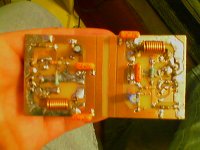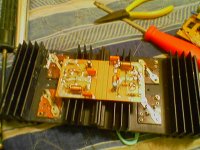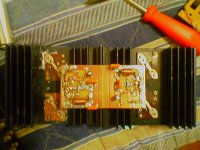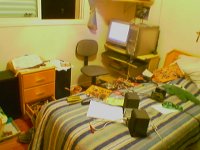-_nando-_ said:
My supply work? 🙂
The output will be +-35.4V
😀
By the way did the supply work
 (or was that a question
(or was that a question  )
)Ps: Sorry i was offline for a couple of days so didnt see your replys.
Venki.😀
I MADE the amp !
I made two 3886s, and I did some modifications in the original schematic from PDF.
The 20K feedback resistor, I replaced with a 22K one, and Ci I didn't put, Ri I replaced with 680Ohms resistor.
The Imput I replaced the 1K resistor, with a Foxconn 4,7uF 50v capacitor, with a 22K resistor to the ground.
It all was based in this:
http://dogbreath.de/Chipamps/GainCardCopy/GainCardCopy.html
And it realy sound better than the original diagram from the PDF 😎
THE SOUND IS GREAT !!!!!!!!!!!!!!!!!!!!!! 😀 😀
I'm running two 3886s with two 5.000uF 50v Siemens caps, with four 20W 4Ohms speakers, that is 8Ohms 40W for each channel 🙂
These are the speakers:
http://www.bravox.com.br/produtos/caixaacustica_mini35.asp
REALY good speakers, I don't know if it's avaliable in your contry
Next step is build a c200 power amp, the elliot's 2 way crossover (centered in 300Hz), and the subwoofer box.
Sealed, vented or Band Pass for sub?
BandPass I think is impratical for a 12 inch subwoofer ahahahah 😱 Imagine the size of the thig HOHOHOHO So, It's OUT.
So, It's OUT.
The question is... SEALED or VENTED???
I know (but I don't know if it's right) that vented can reproduce lower frequences better, and more extended and smoother bass...
But it will run in a dinner room that isn't small... Which one is the best for this application?
Waiting feedback ! 😀
I made two 3886s, and I did some modifications in the original schematic from PDF.
The 20K feedback resistor, I replaced with a 22K one, and Ci I didn't put, Ri I replaced with 680Ohms resistor.
The Imput I replaced the 1K resistor, with a Foxconn 4,7uF 50v capacitor, with a 22K resistor to the ground.
It all was based in this:
http://dogbreath.de/Chipamps/GainCardCopy/GainCardCopy.html
And it realy sound better than the original diagram from the PDF 😎
THE SOUND IS GREAT !!!!!!!!!!!!!!!!!!!!!! 😀 😀
I'm running two 3886s with two 5.000uF 50v Siemens caps, with four 20W 4Ohms speakers, that is 8Ohms 40W for each channel 🙂
These are the speakers:
http://www.bravox.com.br/produtos/caixaacustica_mini35.asp
REALY good speakers, I don't know if it's avaliable in your contry

Next step is build a c200 power amp, the elliot's 2 way crossover (centered in 300Hz), and the subwoofer box.
Sealed, vented or Band Pass for sub?
BandPass I think is impratical for a 12 inch subwoofer ahahahah 😱 Imagine the size of the thig HOHOHOHO
 So, It's OUT.
So, It's OUT.The question is... SEALED or VENTED???

I know (but I don't know if it's right) that vented can reproduce lower frequences better, and more extended and smoother bass...
But it will run in a dinner room that isn't small... Which one is the best for this application?
Waiting feedback ! 😀
I don't want hard bass and high SPL...
I want smooth and extended bass, good for ears... But I want it without distortion, that's why I choiced s 12 inch subwoofer, then I can put it in low volume and have the bass that I want.
I want the most plain frequency response possible, and good reproduction of lower bass, like 20 ~ 40hz. But I'll cut the subwoofer at 300Hz, and the speakers will play 300hz ahead.
I want Sound Quality, not SOUND PRESSURE
😉
Which one do you think is the better for me? Vented or Sealed subwoofer box? The room isn't small, but isn't that big too 😉
I want smooth and extended bass, good for ears... But I want it without distortion, that's why I choiced s 12 inch subwoofer, then I can put it in low volume and have the bass that I want.
I want the most plain frequency response possible, and good reproduction of lower bass, like 20 ~ 40hz. But I'll cut the subwoofer at 300Hz, and the speakers will play 300hz ahead.
I want Sound Quality, not SOUND PRESSURE
😉
Which one do you think is the better for me? Vented or Sealed subwoofer box? The room isn't small, but isn't that big too 😉
Hummm...
May I should open an other topic?
I was writing about 3886, now I'm writing about crossover, solid state amp and subwoofer... 😀
May I should open an other topic?

I was writing about 3886, now I'm writing about crossover, solid state amp and subwoofer... 😀
Sorry Nando - got tied up with another thread! I'd go with a sealed: much easier, more compact, cleaner sound too. Most important thing is to build your sub to withstand a nuclear blast! - loads of bracing, clean joints & liberal adhesive; over-engineer it.
Cheers - Jezz
Cheers - Jezz
Thanks ! I contacted the subwoofer manufacturer, and he will project the box, then I just build it with care! 🙂
But, one problem with 3886s... They are receiving FM RADIO STATION HAhah... What do I do to minimize this?
HAhah... What do I do to minimize this?
Other thing... They are operating with 8Ohms 40W 30+30v, and heating too fast, and not a lot, but enough to worry me ! Are they like this?
Sound is PERFECT, it sounds veeery good indeed ! 😀
The Heatsink isn't that big... medium, not small... But the load is light and supply is ok ! The supply do not heat
Maybe the feedback (22K) resistor and the Ri (680ohms) with Ci ommited makes the chip generate heat? These values and parts are based on 47labs amplifier (gaincard).
When I turn it on with no imput signal, it get WARM, and I think it should be in the ambience temperature, is it right?
But, one problem with 3886s... They are receiving FM RADIO STATION
 HAhah... What do I do to minimize this?
HAhah... What do I do to minimize this?Other thing... They are operating with 8Ohms 40W 30+30v, and heating too fast, and not a lot, but enough to worry me ! Are they like this?
Sound is PERFECT, it sounds veeery good indeed ! 😀
The Heatsink isn't that big... medium, not small... But the load is light and supply is ok ! The supply do not heat

Maybe the feedback (22K) resistor and the Ri (680ohms) with Ci ommited makes the chip generate heat? These values and parts are based on 47labs amplifier (gaincard).
When I turn it on with no imput signal, it get WARM, and I think it should be in the ambience temperature, is it right?
Occasionally, current in the output leads (which function as
antennas) can be coupled through the air to the amplifier
input, resulting in high-frequency oscillation. This normally
happens when the source impedance is high or the input
leads are long. The problem can be eliminated by placing a
small capacitor, CC, (on the order of 50 pF to 500 pF) across
the LM3886 input terminals. Refer to the External Components
Description section relating to component interaction
with Cf. ... from datasheet
You may also want to keep input leads short and twisted.
and try to bypass your caps to the power pins with 0.1uf ceramics or poylprops, if those are too expensive...
Yes, they heat up pretty quick, but should not get too hot, providing you have adequate heatsinking.
With no input it should not realy get warm, so it may be oscilating... Have you measured DC on the outputs yet?
How close are your caps to the power pins? how long are your speaker cables?
The datasheet loves the parallel 10R resistor and 0.7uh inductor on the output, I think this helps especialy for cases of the oscilation fever.
antennas) can be coupled through the air to the amplifier
input, resulting in high-frequency oscillation. This normally
happens when the source impedance is high or the input
leads are long. The problem can be eliminated by placing a
small capacitor, CC, (on the order of 50 pF to 500 pF) across
the LM3886 input terminals. Refer to the External Components
Description section relating to component interaction
with Cf. ... from datasheet
You may also want to keep input leads short and twisted.
and try to bypass your caps to the power pins with 0.1uf ceramics or poylprops, if those are too expensive...
Yes, they heat up pretty quick, but should not get too hot, providing you have adequate heatsinking.
With no input it should not realy get warm, so it may be oscilating... Have you measured DC on the outputs yet?
How close are your caps to the power pins? how long are your speaker cables?
The datasheet loves the parallel 10R resistor and 0.7uh inductor on the output, I think this helps especialy for cases of the oscilation fever.
-_nando-_ said:
But, one problem with 3886s... They are receiving FM RADIO STATIONHAhah... What do I do to minimize this?
Other thing... They are operating with 8Ohms 40W 30+30v, and heating too fast, and not a lot, but enough to worry me ! Are they like this?
The Heatsink isn't that big... medium, not small... But the load is light and supply is ok !
The LM3886 consumes energy even when it is idling (as do most non-switching amplifiers) -- if you go to the National Semiconductor website you will find an interactive search engine which will tell you the thermal impedance of heat sink required as a function of the power supply voltage. http://www.national.com/appinfo/audio/files/Overture_Design_Guide15.xls
From the thermal impedance (theta) you can back out the size of the heatsink required. In this case theta should be ~4.1 Use 32 LFM for air velocity and play with this tool:
http://www.aavidthermalloy.com/technical/thermal.shtml
Radio reception can generally be curbed by placing a 200pf capacitor across the input terminals -- although this is the first time I have heard of FM interference.
Jack
Sorry, I was out few days, and I couldn't post reply ! 😀
I'm building PCB for it, because I first made this amp without PCB, just to see how it sounds. Now, I'm building a PCB with many filters, and two fuses 😉
I'll put this capacitor, to see if the problem is solved 🙂 The enclosure will be connected to GND, to minimize this too ! 🙂
Thanks !!!
I'm building PCB for it, because I first made this amp without PCB, just to see how it sounds. Now, I'm building a PCB with many filters, and two fuses 😉
I'll put this capacitor, to see if the problem is solved 🙂 The enclosure will be connected to GND, to minimize this too ! 🙂
Thanks !!!
Hum... Remember I said that I'll build a c200 to drive the sub?
Problems with this !!! Damm fake transistors...
http://www.diyaudio.com/forums/showthread.php?s=&threadid=71367
Can you believe that there's MUCH MORE fake transistors than genuine ones in my country?? The worse is, most of people never heard about fake transistors!
What a shame...
Problems with this !!! Damm fake transistors...
http://www.diyaudio.com/forums/showthread.php?s=&threadid=71367
Can you believe that there's MUCH MORE fake transistors than genuine ones in my country?? The worse is, most of people never heard about fake transistors!
What a shame...

I tested it today, and all old problems were solved, no more RF interference and heat. I think it was heating because of oscilation, as the Nordic said ! Now it's much more cold.
Two 0,1uF 250V polyester caps were added between supply rails and the ground. And in the imput I added one 100pF to the ground, and finaly at the output, I added the 0,7uH with 10R resistor, to prevent oscilation 🙂
Everything is fine and cold now ! 😀
Thanks to ALL OF YOU that helped me to solve those problems !
And I'm still waiting for feedback ! 😎
Two 0,1uF 250V polyester caps were added between supply rails and the ground. And in the imput I added one 100pF to the ground, and finaly at the output, I added the 0,7uH with 10R resistor, to prevent oscilation 🙂
Everything is fine and cold now ! 😀
Thanks to ALL OF YOU that helped me to solve those problems !
And I'm still waiting for feedback ! 😎
For sure nordic ! 😎
Now, I'm ordering parts to build my SUB AMP (ampslab), and the 24Db/Octave Linkwitz Active Crossover, from Elliots Site !
I finishied just one part of the project... I have to build the enclosure, supply, crossover, subamp, sub box, and of course set all this to the better sound possible !
Lots of things to do yet ! 😱
Now, I'm ordering parts to build my SUB AMP (ampslab), and the 24Db/Octave Linkwitz Active Crossover, from Elliots Site !
I finishied just one part of the project... I have to build the enclosure, supply, crossover, subamp, sub box, and of course set all this to the better sound possible !
Lots of things to do yet ! 😱
- Status
- Not open for further replies.
- Home
- Amplifiers
- Chip Amps
- LM 3886 Tips...






